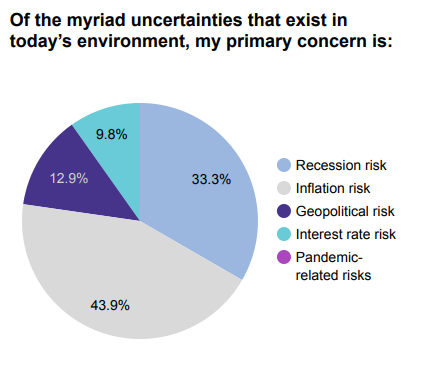Even before the Federal Reserve hiked interest rates this week, advisors told VettaFi they had been tactically changing their exposure to fixed income. During a VettaFi webcast on Tuesday with American Century, advisors overwhelmingly cited inflation risk (44% of respondents) and recession risk (33%) as the primary concerns they had when investing, significantly ahead of risks specifically tied to geopolitical, interest rate, and pandemic factors.

The follow-up poll question VettaFi asked advisors was to cite any actions they had already taken to address these concerns. Many respondents said they had either taken no action and chosen to maintain long-term allocations or cited a combination of moves. However, those that selected just one cited the act of rotating allocations within fixed income, such as from intermediate- to short-duration, most frequently; other choices included reducing allocation to fixed income or equities, rotating allocation within equities (such as from growth to value), and increasing allocation to alternatives and commodities.
There are a range of short-duration fixed income ETFs that advisors should consider. For example, there are ultra-short-term active and index-based ETFs, such as the JPMorgan Ultra-Short Income ETF (JPST), the PIMCO Enhanced Short Maturity ETF (MINT), and the SPDR Bloomberg 1-3 Month T Bill ETF (BIL), which can significantly lower the risks of an asset allocation portfolio. These ETFs tend to have an average duration of less than one year.
For advisors seeking a little more income in exchange for moderately more interest rate risk, there are less sensitive index-based investment-grade and high yield corporate bond ETFs. The list includes the iShares 1-5 Year Investment Grade Corporate Bond ETF (IGSB), the SPDR Bloomberg Short Term High Yield Bond ETF (SJNK), and the Vanguard Short-Term Corporate Bond ETF (VCSH). These ETFs tend to have an average duration of under three years.
In addition, there are ETFs that invest in floating-rate investment-grade or more speculative-grade loans, including the Invesco Senior Loan ETF (BKLN), the iShares Floating Rate Bond ETF (FLOT), and the WisdomTree Floating Rate Treasury Fund (USFR).
During the webcast, American Century, which offers the American Century Quality Preferred ETF (QPFF), also commented that preferred securities have historically shown to be resilient in past rising rate environments. The First Trust Preferred Securities & Income ETF (FPE) and the Global X U.S. Preferred ETF (PFFD) are two more ETFs offering exposure to preferred securities.
This is just a sample of ETFs available for advisors to consider, as most asset managers offer a suite of products with an average duration below that of the Bloomberg Aggregate Bond Index.
While many advisors took action before the Federal Reserve aggressively raised interest rates, this does not mean those that initially maintained long-term allocations have missed out. Interest rates are likely to climb higher as the Federal Reserve seeks to tame inflation, while forestalling a recession. Advisors would be well suited to take a look at the range of less rate-sensitive fixed income ETFs.
To see more of Todd’s research, reports, and commentary on a regular basis, please subscribe here.
For more news, information, and strategy, visit VettaFi.


